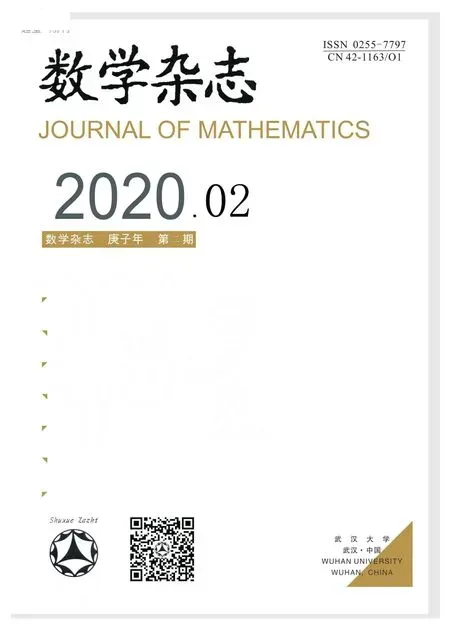RESEARCH ANNOUNCEMENTS ON“RIGIDITY OF THURSTON’S SPHERE PACKINGS ON 3-DIMENSIONAL MANIFOLDS”
HE Xiao-kai, XU Xu
(1.School of Mathematics and Computational Science, Hunan First Normal University,Changsha 410205, China)
(2.School of Mathematics and Statistics, Wuhan University, Wuhan 430072, China)
1 Introduction and Main Results
In the study of hyperbolic metrics on 3-dimensional manifolds,Thurston(see[9],Chapter 13)introduced Thurston’s circle packing on surfaces,which allows the circles to intersects with non-obtuse angles and is a natural generalization of the tangential circle packing studied by Andreev [1, 2]and Koebe [6].Thurston further proved the Andreev-Thurston theorem,the rigidity of which states that Thurston’s circle packing metric is determined by the discrete curvature defined at the vertices of the triangulated surfaces.
A longstanding problem since Thurston’s circle packing on surfaces was introduced is whether Thurston’s circle packing could be generalized to three or higher dimensional manifold with the properties of circle packing on surfaces preserved, specially the rigidity and the existence.The first attempt was made by Cooper-Rivin [3], who introduced the tangential sphere packing on 3-dimensional manifold.Suppose (M,T) is a triangulated connected closed 3-dimensional manifold with a triangulation T =(V,E,F,T),where V,E,F,T denote the set of vertices, edges, faces and tetrahedra, respectively.
Definition 1.1A tangential sphere packing metric is a map r : V →(0,+∞) such that the length lijof the edge {ij} ∈E is ri+ rjand for any topological tetrahedron{ijkl} the lengths lij,lik,lil,ljk,ljl,lklform the edge lengths of a nondegenerate Euclidean or hyperbolic tetrahedron.
Theorem 1.1 (see [3–5, 7])Suppose(M,T)is a closed 3-dimensional triangulated manifold.Then a Euclidean or hyperbolic tangential sphere packing on (M,T) is locally determined by the combinatorial scalar curvature(up to scaling for the Euclidean background geometry).
The global rigidity of tangential sphere packing on 3-dimensional manifolds was conjectured by Cooper-Rivin [3]and proved by the second author [10].
Theorem 1.2 (see [10])Suppose (M,T) is a closed connected triangulated 3-manifold.
(1) A Euclidean tangential sphere packing metric on (M,T) is determined by its combinatorial scalar curvature K :V →R up to scaling.
(2) A hyp erbolic tangential sphere packing metric on (M,T) is determined by its combinatorial scalar curvature K :V →R.
Thurston’s sphere packing on 3-dimensional manifolds is an analogy of Thurston’s circle packing on surfaces and a natural generalization of Cooper-Rivin’s tangential sphere packing on 3-manifolds with the edge length lijgiven by

for Euclidean background geometry and lij= cosh?1(cosh ricosh rj+sinh risinh rjcos Φij)for the hyperbolic background geometry, where Φ :is a weight on the edges corresponding to the intersection angle of the spheres attached to the vertices i and j.If Φ ≡ 0, Thurston’s sphere packing is reduced to Cooper-Rivin’s tangential sphere packing.For Thurston’s sphere packing, one can also define the combinatorial scalar curvature.
Definition 1.2Suppose(M,T,Φ)is a weighted triangulated closed 3-manifold with a nondegenerate sphere packing metric.The combinatorial scalar curvature at a vertex i for Thurston’s sphere packing metric is defined to be

Recently, we proved the local rigidity of a large class of Thurston’s sphere packings,which has been open for many years.This generalizes Cooper-Rivin-Glickstein’s local rigidity for tangential sphere packing [3–5, 7]and confirms a strong local Stoker conjecture for cone 3-manifolds generated by Thurston’s Euclidean sphere packing metrics [8].
Theorem 1.3Suppose (M,T) is a triangulated closed connected 3-manifold with a weightsatisfying the condition

We also proved the infinitesimal rigidity of Thurston’s Euclidean sphere packing, which confirms a strong infinitesimal Stoker conjecture for cone 3-manifolds generated by Thurston’s Euclidean sphere packing metrics [8].
Theorem 1.4Suppose (M,T) is a triangulated closed connected 3-manifold with a weightsatisfying (1.1) or (1.2).Then Thurston’s Euclidean sphere packing on (M,T,Φ) can not be deformed (except by scaling) while keeping the combinatorial Ricci curvatures along the edges fixed.

